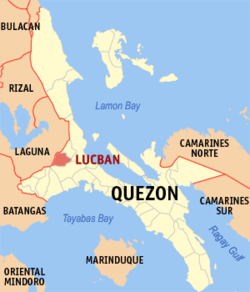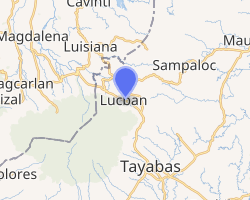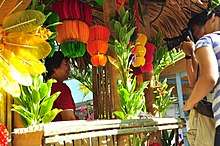Lucban
Lucban, officially the Municipality of Lucban (Tagalog: Bayan ng Lukban), is a 2nd class municipality in the province of Quezon, Philippines. According to the 2015 census, it has a population of 51,475 people.[4]
Lucban | |
|---|---|
| Municipality of Lucban | |
Municipal Hall, Kamay Ni Hesus Healing Shrine, Saint Louis of Tolouse Parish Church, Downtown area, Plaza | |
 Seal | |
Nickname(s):
| |
| Motto(s): Yanong Rikit! Baling Ganda! | |
 Map of Quezon with Lucban highlighted | |
OpenStreetMap 
| |
.svg.png) Lucban Location within the Philippines | |
| Coordinates: 14°06′48″N 121°33′25″E | |
| Country | |
| Region | Calabarzon (Region IV-A) |
| Province | Quezon |
| District | 1st District |
| Founded | August 19, 1578 [1] |
| Barangays | 32 (see Barangays) |
| Government | |
| • Type | Sangguniang Bayan |
| • Mayor | Celso Olivier T. Dator |
| • Vice Mayor | Moises “BonBon” B. Villaseñor |
| • Congressman | Wilfrido Mark M. Enverga |
| • Electorate | 29,272 voters (2019) |
| Area | |
| • Total | 130.46 km2 (50.37 sq mi) |
| Population (2015 census)[4] | |
| • Total | 51,475 |
| • Density | 390/km2 (1,000/sq mi) |
| • Households | 11,342 |
| Economy | |
| • Income class | 2nd municipal income class |
| • Poverty incidence | 3.77% (2015)[5] |
| • Revenue (₱) | 143,171,013.52 (2016) |
| Time zone | UTC+8 (PST) |
| ZIP code | 4328 |
| PSGC | |
| IDD : area code | +63 (0)42 |
| Climate type | tropical rainforest climate |
| Native languages | Tagalog |
| Website | www |
Lucban is dubbed as the Art Capital of Quezon province. It is accessible by land from Metro Manila Passing Through Rizal Province Via Manila East Road or Via South Luzon Expressway
The municipality is known for its annual Pahiyas Festival, which is held every May 15 in honor of San Isidro Labrador the Farmer.
History
Second World War and Japanese Occupation
Early in the campaign, Japanese forces invaded and occupied on the town of Lucban. On December 26, 1941, Filipino and American troops defended Barrio Piis and the attack by the Japanese shifted to the Bataan Peninsula. After the Japanese forces occupied the town, they built a military garrison and Japanese Armed Forces were stationed in Lucban. Both local guerrilla and regular troops of the Philippine Commonwealth Army initiated attacks in Lucban from 1942 to 1945.
Sampaloc, Quezon
Sampaloc used to be the Barrio Dingin of Lucban, Quezon consisting of three sitios. It was later renamed into Sampaloc because of the presence of a large tamarind tree found in the center of the settlement during the earlier days. The name was also changed in Alfonso Trece for a time to honor the King of Spain. In 1873, Capt. Pedro Cadelina of Lucban recommended to change the barrio into a municipality but due to lack of residents, it was only made into a “visita”. “Teniente Mayores” were appointed to head the ”visita”, the first of whom was from Polilio, followed by Arcadio Veluya, Laureano Nanola, Silverio Abueva and Juan Saludades. Through the efforts of Juan Pineda, Sampaloc became a municipality in 1892. He was elected as the first Capitan. He was succeeded by Diego Gagan followed by Teofilo Daya in 1901. During Daya's term in the office, three more barrios from Mauban – Banot, Bilucao and San Bueno, became a part of Sampaloc through the efforts of Ireneo Domeo, the municipal secretary. The town was also renamed to Sampaloc during this time.
Etymology
Legend has it the town derives its name from the lukbán or pomelo tree. Three hunters from neighbouring Majayjay— namely Marcos Tigla, Luis Gamba and Lucas Mañawa— lost their way following the trail of wild animals at the foot of volcanic Mount Banahaw. Resting under a tree, they saw a crow (uwák) in the tree's branches, and believing this to be a bad omen, they moved to another place and rested again. Whilst in the shade of a large pomelo (lucbán) tree, the trio were attracted to a couple of kingfishers (salacsác) that were singing. Fascinated by the bird's plumage and rhythmic chirps, the superstitious hunters took this a sign of good fortune and thus settled in the place they named "Lucbán."
Barangays
Lucban is politically subdivided into 32 barangays.
- Abang
- Aliliw
- Atulinao
- Ayuti (Poblacion)
- Barangay 1 (Poblacion)
- Barangay 2 (Poblacion)
- Barangay 3 (Poblacion)
- Barangay 4 (Poblacion)
- Barangay 5 (Poblacion)
- Barangay 6 (Poblacion)
- Barangay 7 (Poblacion)
- Barangay 8 (Poblacion)
- Barangay 9 (Poblacion)
- Barangay 10 (Poblacion)
- Igang
- Kabatete
- Kakawit
- Kalangay
- Kalyaat
- Kilib
- Kulapi
- Mahabang Parang
- Malupak
- Manasa
- May-It
- Nagsinamo
- Nalunao
- Palola
- Piis
- Samil
- Tiawe
- Tinamnan
Demographics
| Year | Pop. | ±% p.a. |
|---|---|---|
| 1903 | 10,227 | — |
| 1918 | 12,913 | +1.57% |
| 1939 | 13,976 | +0.38% |
| 1948 | 15,060 | +0.83% |
| 1960 | 17,452 | +1.24% |
| 1970 | 23,157 | +2.87% |
| 1975 | 23,044 | −0.10% |
| 1980 | 25,826 | +2.30% |
| 1990 | 30,130 | +1.55% |
| 1995 | 35,128 | +2.92% |
| 2000 | 38,834 | +2.17% |
| 2007 | 45,616 | +2.24% |
| 2010 | 46,698 | +0.86% |
| 2015 | 51,475 | +1.87% |
| Source: Philippine Statistics Authority[4][6][7][8] | ||
Climate
| Climate data for Lucban, Quezon | |||||||||||||
|---|---|---|---|---|---|---|---|---|---|---|---|---|---|
| Month | Jan | Feb | Mar | Apr | May | Jun | Jul | Aug | Sep | Oct | Nov | Dec | Year |
| Average high °C (°F) | 24 (75) |
25 (77) |
27 (81) |
29 (84) |
29 (84) |
28 (82) |
27 (81) |
26 (79) |
26 (79) |
26 (79) |
26 (79) |
24 (75) |
26 (80) |
| Average low °C (°F) | 18 (64) |
18 (64) |
18 (64) |
19 (66) |
21 (70) |
22 (72) |
21 (70) |
21 (70) |
21 (70) |
20 (68) |
20 (68) |
19 (66) |
20 (68) |
| Average precipitation mm (inches) | 52 (2.0) |
35 (1.4) |
27 (1.1) |
27 (1.1) |
82 (3.2) |
124 (4.9) |
163 (6.4) |
144 (5.7) |
145 (5.7) |
141 (5.6) |
100 (3.9) |
102 (4.0) |
1,142 (45) |
| Average rainy days | 12.0 | 8.1 | 8.8 | 9.7 | 17.9 | 22.6 | 26.2 | 24.5 | 24.6 | 22.0 | 16.7 | 14.9 | 208 |
| Source: Meteoblue [9] | |||||||||||||
Local Government
Government Officials
Elected Officials of Lucban as per May 2019 Election:[10]
- Shiela Deveza (NP) -
| Position | Name |
|---|---|
| Municipal Mayor | Celso Olivier "Oli" Dator (NPC) |
| Vice Mayor | Moises 'Bonbon' Villaseñor (LAKAS) |
| Councilors | |
| Arnel Abcede (NPC) | |
| Jun Ver (NPC) | |
| Marife Hari (NPC) | |
| Alejandro Salvatierra (NPC) | |
| Enrique Buctil (NPC) | |
| Dolfo Tupas (NP) | |
| Howard Cadiz (NPC) | |
| Ever Oblea (LBP) | |
| Lois Conrad Salumbides (SKP) |
Pahiyas Festival

Lucban celebrates the Pahiyas Festival every May 15 in honor of the patron saint of farmers, St Isidore the Labourer. Beginning with a 6:00am mass at the Lucban Church,[11] this festival showcases a street of houses which are adorned with fruits, vegetables, agricultural products, handicrafts and kiping, a rice-made decoration, which afterwards can be eaten grilled or fried. The houses are judged and the best one is proclaimed the winner. Every year, tourists roam the municipality to witness the decoration of houses. Nowadays, Pahiyas Festival is a week long celebration starting every 15 May.[12][13]
Lucban Events and Festivals
- Good Friday - Mahal na Señor
- Easter Sunday - Buhusan Festival
- May 15 - Lucban San Isidro Labrador Pahiyas Festival
- August 18 - Araw ng Lucban
- August 19 - Pista ng Lucban
- November 4 - Apolinario Dela Cruz (Hermano Pule) Day
Educational Institutions
Public Research University
Secondary Schools:
- Casa del Niño Jesus de Lucban - High School
- Banahaw View Academy
- Lucban Academy
- One in Christ Church School of Lucban Inc.
- Paaralang Sekundarya ng Lucban Integrated School
- Nagsinamo National High School
- Lucban Christian School - Junior High School
Elementary Schools:
- Steadfast Love Kiddie School
- Casa Del Niño Jesus de Lucban
- Good Shepherd Diocesan School-Philippine Independent Church
- Paaralang Elementarya ng Lucban 1
- Paaralang Elementarya ng Lucban 2
- Paaralang Elementarya ng Lucban 3A
- Paaralang Elementarya ng Lucban 3B
- Paaralang Elementarya ng Lucban 4
- Paaralang Elementarya ng Lucban 5
- Paaralang Elementarya ng Lucban 6
- Paaralang Elementarya ng Lucban 7
- Paaralang Elementarya ng Lucban-Maka
- Paaralang Elementarya ng Lucban-May-it Manasa
- Paaralang Elementarya ng Lucban-Nagsinamo
- Paaralang Elementarya ng Lucban-Nakal
- Paaralang Elementarya ng Lucban-Piis
- Lucban Adventist Elementary School
- Lucban Christian School
References
- "VP Leni Robredo". www.facebook.com. Retrieved 5 January 2019.
- "Municipality". Quezon City, Philippines: Department of the Interior and Local Government. Retrieved 31 May 2013.
- "Province: Quezon". PSGC Interactive. Quezon City, Philippines: Philippine Statistics Authority. Retrieved 12 November 2016.
- Census of Population (2015). "Region IV-A (Calabarzon)". Total Population by Province, City, Municipality and Barangay. PSA. Retrieved 20 June 2016.
- "PSA releases the 2015 Municipal and City Level Poverty Estimates". Quezon City, Philippines. Retrieved 1 January 2020.
- Census of Population and Housing (2010). "Region IV-A (Calabarzon)". Total Population by Province, City, Municipality and Barangay. NSO. Retrieved 29 June 2016.
- Censuses of Population (1903–2007). "Region IV-A (Calabarzon)". Table 1. Population Enumerated in Various Censuses by Province/Highly Urbanized City: 1903 to 2007. NSO.
- "Province of Quezon". Municipality Population Data. Local Water Utilities Administration Research Division. Retrieved 17 December 2016.
- "Lucban: Average Temperatures and Rainfall". Meteoblue. Retrieved 27 January 2020.
- "Elected Officials of Lucban". DILG.
- "Pahiyas Festival in Lucban, Quezon! Viva San Isidro Labrador!". ivanhenares.com. 18 May 2014. Retrieved 23 December 2014.
- "iWitness: Ang kuwago ng Pahiyas". GMA News. Retrieved 5 January 2019.
- manilatimes.net, Harvesting Pahiyas, A rice festival in the midst of a food crisis Archived 2008-05-30 at the Wayback Machine
External links
| Wikimedia Commons has media related to Lucban, Quezon. |